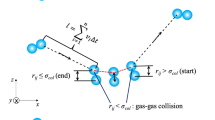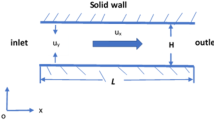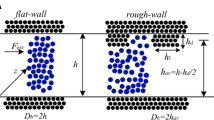Abstract
Gas flows over a wide range of Knudsen numbers (~0.5–10) are studied using silicon nanochannel arrays with slit-shaped pores. The pore sizes of the silicon nanochannel arrays range from micrometer to sub-10-nm scales. The flows are generated under conditions of room temperature and near-atmospheric pressure (~22°C and ~101–115 kPa) and span the continuum flow, continuum-slip flow, transition flow and free-molecular flow regimes. The measured flow rates of helium, argon and carbon dioxide are in good agreement with a theoretical model (Unified Slip Model) proposed by Beskok and Karniadakis (Nanoscale Microscale Thermophys Eng 3:43–77, 1999).






Similar content being viewed by others
Abbreviations
- STP:
-
Standard temperature and pressure
- USM:
-
Unified slip model
References
Agrawal A, Agrawal A (2006) Three-dimensional simulation of gaseous slip flow in different aspect ratio microducts. Physics of Fluids 18(103604):1–11
Arkilic E, Schmidt MA, Breuer KS (1997) Gaseous slip flow in long microchannels. J MEMS 6:167–178
Arkilic E, Breuer KS, Schmidt MA (2001) Mass flow and tangential momentum accommodation in silicon micromachined channels. J Fluid Mech 437:29–43
Berman AS (1965) Free molecule transmission probabilities. J Appl Phys 36:3356
Berman AS (1966) Erratum: free molecule transmission probabilities. J Appl Phys 37
Beskok A, Karniadakis GE (1999) Report: a model for flows in channels, pipes, and ducts at micro and nano scales. Nanoscale Microscale Thermophys Eng 3(1):43–77
Bird GA (1978) Monte Carlo simulation of gas flows. Annual Rev Fluid Mech 10(1):11–31
Bird GA (2003) Molecular gas dynamics and the direct simulation of gas flows. Clarendon Press, Oxford
Bird RB, Lightfoot EN, Steward WE (2002) Transport phenomena. Wiley, New York
Bonhomme F, Welk ME, Nenoff TM (2003) CO2 selectivity and lifetimes of high silica ZSM-5. Microporous Mesoporous Mater 66:181–188
Carman PC (1956) The flow of gases through porous media. Academic Press, New York
Cercignani C (1988) The Boltzmann equation and its applications. Springer, New York
Chapman CL, Bhattacharyya D, Eberhart RC, Timmons RB, Chuong CJ (2008) Plasma polymer thin film depositions to regulate gas permeability through nanoporous track etched membranes. J Membr Sci 318:137–144
Chu WH, Chin R, Huen T, Ferrari M (1999) Silicon membrane nanofilters from sacrificial oxide removal. J Microelectromech Syst 8(1):34–42
Desai TA, Chu WH, Tu JK, Beattie GM, Hayek A, Ferrari M (1998) Microfabricated immunoisolating biocapsules. Biotechnol Bioeng 57(1):118–120
Didier RFG (1994) Aerodynamics of shuttle orbiter at high altitudes. J Spacecr Rocket 31:944–952
Dongari N, Agrawal A, Agrawal A (2007) Analytical solution of gaseous slip flow in long microchannels. Int J Heat Mass Transf 50:3411–3421
Ewart T, Perrier P, Graur IA, Meolans JG (2007) Mass flow rate measurements in a microchannel, from hydrodynamic to near free molecular regimes. J Fluid Mech 584:337–356
Fissell WH, Manley S, Westover A, Humes HD, Fleischman AJ, Roy S (2006) Differentiated growth of human renal tubule cells on thin-film and nanostructured materials. ASAIO J 52:221–227.
Fissell WH, Dubnisheva A, Eldridge AN, Fleischman AJ, Zydney AL, Roy S (2009) High-performance silicon nanopore hemofiltration membranes. J Membr Sci 326:58–63
Gad-el-Hak M (1999) The fluid mechanics of microdevices—the freeman scholar lecture. J Fluid Eng 121:5–33
Grattoni A, De Rossa E, Ferrati S, Wang Z, Gianesini A, Liu X, Hussain F, Goodall R (2009) Analysis of a nanochanneled membrane structure through convective gas flow. J Micromech Microeng 19:1–11
Gruener S, Huber P (2008) Knudsen diffusion in silicon nanochannels. Phys Rev Lett 100(6):64502
Hadjiconstantinou NG (2003) Comment on Cercignani’s second-order slip coefficient. Phys Fluids 15:2352–2354
Harley JC, Huang Y, Bau H, Zemel JN (1995) Gas flow in micro-channels. J Fluid Mech 284:257–274
Hwang ST, Kammermeyer K, Weissberger A (1975) Membranes in separations. Wiley-Interscience, New York
Jousten K (2008) Handbook of vacuum technology. Vch Verlagsgesellschaft Mbh
Kalweit M, Drikakis D (2009) Coupling strategies for hybrid molecular-continuum simulation methods. J Mech Eng Sci 222:797–806
Kanani DM, Fissell WH, Roy S, Dubnisheva A, Fleischman A, Zydney AL (2009) Permeability—selectivity analysis for ultrafiltration: effect of pore geometry. J Memb Sci 349:405–410
Karniadakis GE, Beskok A, Aluru NR (2005) Microflows and nanoflows: fundamentals and simulation. Springer, New York
Kaye GWC, Laby TH (1995) Tables of physical and chemical constants, 16th edn. Longman, London
Kleijn CR, Dorsman R, Kuijlaars KJ, Okkerse M, van Santen H (2007) Multi-scale modeling of chemical vapor deposition processes for thin film technology. J Cryst Growth 303:362–380
Magistrelli JM (2004) Investigation of fluid flow through silicon nanoporous membranes. MS Thesis, Case Western Reserve University
Maxwell JC (1890) On the condition to be satisfied by a gas at the surface of a solid body. In: Niven WD (ed) The scientific papers of James Clerk Maxwell, vol 2. Cambridge University Press, London, p 704
Pabby AK, Rizvi SSH, Sastre AM (2008) Handbook of membrane separations: chemical, pharmaceutical FOOD and biotechnological applications. CRC press, New York
Pong K, Ho C, Liu J, Tai Y (1994) Non-linear pressure distribution in uniform microchannels. In: Appl. Microfabrication to Fluid Mechanics, ASME Winter Annu. Meet. Chicago, IL, Nov. 1994, pp 51–56
Robertson JK, Wise KD (2001) Modeling a microfluidic system using Knudsen’s empirical equation for flow in a transition regime. J Vacuum Sci Technol A 19:358–364
Roy S, Raju R, Chuang HF, Cruden BA, Meyyappan M (2003) Modeling gas flow through microchannels and nanopores. J Appl Phys 93:48704879
Sali JV, Patil SB, Jadkar SR, Takwale MG (2001) Hot-wire CVD growth simulation of thickness uniformity. Thin Solid Films 395:66–70
Sharipov F, Seleznev V (1998) Data on internal rarefied gas flows. J Phys Chem Ref Data 27:657
Steckelmacher W (1978) The effect of cross-sectional shape on the molecular flow in long tubes. Vacuum 28:269–275
Unnikrishnan S, Jansen HV, Falke FH, Tas NR, Van Wolferen H, De Boer MJ, Sanders RGP, Elwenspoek MC (2009) Transition flow through an ultra-thin nanosieve. Nanotechnology 20:305304
Verma B, Demsis A, Agrawal A, Prabhu SV (2009) Semi empirical correlation for friction factor with gas flow through smooth microtube. J Vacuum Sci Technol A 27(3):584–590
Acknowledgments
The authors would like to thank the following people for their assistance: Anna Dubnisheva and Illya Gordon at the Cleveland Clinic for fabrication and testing supplies, respectively; and David Jacqmin of NASA Glenn Research Center for discussions on experimental setup. This project was partially supported by grants from the NASA John Glenn Biomedical Engineering Consortium and a NIH Grant R01EB008049 administered by the NIBIB.
Author information
Authors and Affiliations
Corresponding author
Rights and permissions
About this article
Cite this article
Fissell, W.H., Conlisk, A.T., Datta, S. et al. High Knudsen number fluid flow at near-standard temperature and pressure conditions using precision nanochannels. Microfluid Nanofluid 10, 425–433 (2011). https://doi.org/10.1007/s10404-010-0682-4
Received:
Accepted:
Published:
Issue Date:
DOI: https://doi.org/10.1007/s10404-010-0682-4




